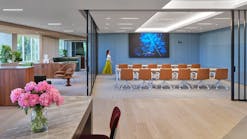New ams Osram boss travels straight away to Malaysian micro LED site
It didn’t take long for ams Osram's new boss to visit Malaysia and check on the all-important billion dollar plant expansion there. On a recent phone call with analysts, Aldo Kamper revealed that he toured the Kulim site about two weeks after joining the Austrian company as CEO.
The upshot: Yes, Kamper told the analysts, ams Osram is currently committing atypically high “capital expenditure” to the facility. Yes, he assured them, construction is on schedule. And yes, he said, it is well worth it, because the plant will help secure a leading place in micro LEDs, which ams Osram and others consider to be the future of display technology — especially for small devices and possibly for large ones, too.
The Kulim expansion has come under repeated scrutiny ever since ams Osram announced in spring 2022 that it would spend nearly $1 billion there to build what it says will be the world's first LED production facility to use 8-inch wafers.
Ams Osram plans to use the factory to churn out micro LEDs and LEDs. The facility will sit alongside the €370 million plant that Osram opened in 2017, a few years before Premstaetten-based ams acquired Munich-based Osram. The existing facility uses 6-inch wafers; the coming 8-inch wafers can be more economical because they yield more chips.
In what looks like a race to complete construction in time for startup in 2024, ams Osram’s capital expenditures (capex) shot up noticeably above the company’s normal levels. Kamper, who took the reins on April 1, told analysts on last week’s first-quarter results call that the €302 million in capex for the quarter was 33% of revenues, a big jump from the 20% in the last quarter of 2022, and off the charts when compared to the 9% for the first quarter a year earlier. The average in 2022 was 11%.
The quarter ended before Kamper arrived, but he seems fully supportive of the capex level, which he expects to be just under €1 billion for the full year 2023.
Spend money to make money
Ams Osram believes the outlay is necessary to help return the company to growth. Sales and earnings crashed in the first quarter, continuing a downward spiral. Kamper is considering shedding some of the expansive portfolio of optical chips and sensors from the ams side of the stable in a potential repointing of the business. Paring back in those areas could help buttress operations in Kulim.
“We are continuing our significant investment into state-of-the-art and industry-leading manufacturing capabilities, which is a key element of our long-term strategy,” Kamper said on the call. “In line with this, we saw a strong sequential increase in capex in Q1, predominantly driven by the investment for the industry first 8-inch LED front end facility we are building at the moment in Kulim, Malaysia.
“We are very satisfied with the progress of this very large scale project. Construction continues to progress on schedule, as I saw for myself during a visit there two weeks ago. We are closing in on completion of the building. After this, we will see the build-out of support infrastructure, and more and more plant equipment deliveries.”
In visiting Kulim, Kamper picked up where he left off about four years ago before leaving his post at the then stand-alone Osram, where he ran the chip division but departed to run German automotive supplier Leoni AG. While at Osram, he played a key role in opening Kulim in 2017. With Kulim shaping up as vital to ams Osram's future, the company hired him back as CEO, replacing former CEO Alexander Everke.
Margin delay
One analyst asked Kamper whether the plant would be a drag on profit margins in 2024, since it is scheduled to ramp up during that year, but is not expected to generate significant revenue until 2025.
“There will be a certain headwind that we have to manage through,” Kamper replied. “That is, I think, part of the plan. It is clear that you have ramp-up costs if you build up a new fab, and especially on new technologies; if you start to work through the kinks in the cable in ’24 to be ready for ’25, it will be costly so there will be some headwinds out of that. Of course we'll work hard to minimize that, but ramping a large facility like that will have a certain impact.” Ams Osram has communicated that trajectory previously, he added.
While capex will decline in 2024, it will continue to be comparatively high.
“There’s no question that ’23 is the the highest spending year on capex, but I would expect that in ’24 there is still also some work to be done above the average,” Kamper said. “The direction will be a significant step down, but it will still be above the average cycle.”
On the call last week, Kamper also indicated that ams Osram will be renegotiating some loans that mature in 2025.
MARK HALPER is a contributing editor for LEDs Magazine, and an energy, technology, and business journalist ([email protected]).
Follow our LinkedIn page for our latest news updates, contributed articles, and commentary, and our Facebook page for events announcements and more. You can also find us on Twitter.

Mark Halper | Contributing Editor, LEDs Magazine, and Business/Energy/Technology Journalist
Mark Halper is a freelance business, technology, and science journalist who covers everything from media moguls to subatomic particles. Halper has written from locations around the world for TIME Magazine, Fortune, Forbes, the New York Times, the Financial Times, the Guardian, CBS, Wired, and many others. A US citizen living in Britain, he cut his journalism teeth cutting and pasting copy for an English-language daily newspaper in Mexico City. Halper has a BA in history from Cornell University.





